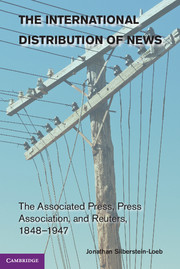 The International Distribution of News
The International Distribution of News Book contents
- Frontmatter
- Dedication
- Contents
- List of Tables
- Acknowledgments
- 1 Introduction
- 2 Conceiving Cooperation among American Newspapers, 1848–1892
- 3 Cooperation, Competition, and Regulation in the United States, 1893–1945
- 4 The “Rationalist Illusion,” the Post Office, and the Press, 1868–1913
- 5 Private Enterprise, Public Monopoly, and the Preservation of Cooperation in Britain, 1914–1941
- 6 Reluctant Imperialist? Reuters in the British Empire, 1851–1947
- 7 Cartel or Free Trade: Supplying the World’s News, 1856–1947
- 8 Conclusion
- Bibliography
- Index
- References
8 - Conclusion
Published online by Cambridge University Press: 05 July 2014
- Frontmatter
- Dedication
- Contents
- List of Tables
- Acknowledgments
- 1 Introduction
- 2 Conceiving Cooperation among American Newspapers, 1848–1892
- 3 Cooperation, Competition, and Regulation in the United States, 1893–1945
- 4 The “Rationalist Illusion,” the Post Office, and the Press, 1868–1913
- 5 Private Enterprise, Public Monopoly, and the Preservation of Cooperation in Britain, 1914–1941
- 6 Reluctant Imperialist? Reuters in the British Empire, 1851–1947
- 7 Cartel or Free Trade: Supplying the World’s News, 1856–1947
- 8 Conclusion
- Bibliography
- Index
- References
Summary
Between 1848 and 1947, institutional arrangements protected the supply of news. In the United States, weak regulation of telegraphy, permissive state laws, and favorable court decisions facilitated the maintenance of an exclusive form of news association that privileged those newspapers fortunate enough to be among its members. Although the AP’s exclusive organization encouraged the emergence of rivals, competition was always contrived. When the UP threatened the AP, the latter became more inclusive. To increase the number of newspapers that benefited from the fruits of cooperation, AP v. US prohibited the association from excluding newspapers from membership based on concerns about newspaper competition. After the Supreme Court forced open the AP in 1945, as the Illinois Supreme Court had done in 1900, the AP resembled a public utility. In this respect, it was similar to the British PA, which from the time of its establishment in 1868 was required by the Post Office to provide its news reports to all paying provincial newspapers.
In Britain, the Telegraph Act of 1868, and continued attempts to maintain the market structure it engendered, provided considerable protection for the provincial press until World War I. The operation of telegraphy in Britain enabled members of the PA to benefit from the comparative wealth of the London press and from the revenues of Extel and Reuters. First telephony and then the onset of war in 1914 contributed to undermining the mid-Victorian settlement brought about by the Telegraph Act. After the war, it broke down entirely. Protection for the supply of news continued but shifted from the press to radio. By 1930, the PA had largely ceased to rely on the public system of telegraphy the Post Office provided, and instead developed a private network of leased lines.
- Type
- Chapter
- Information
- The International Distribution of NewsThe Associated Press, Press Association, and Reuters, 1848–1947, pp. 226 - 232Publisher: Cambridge University PressPrint publication year: 2014
